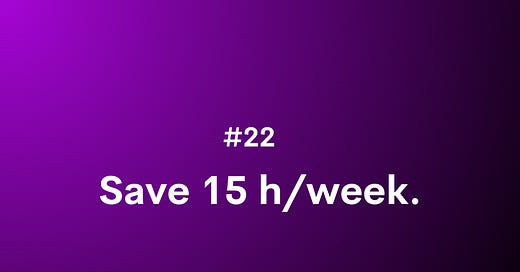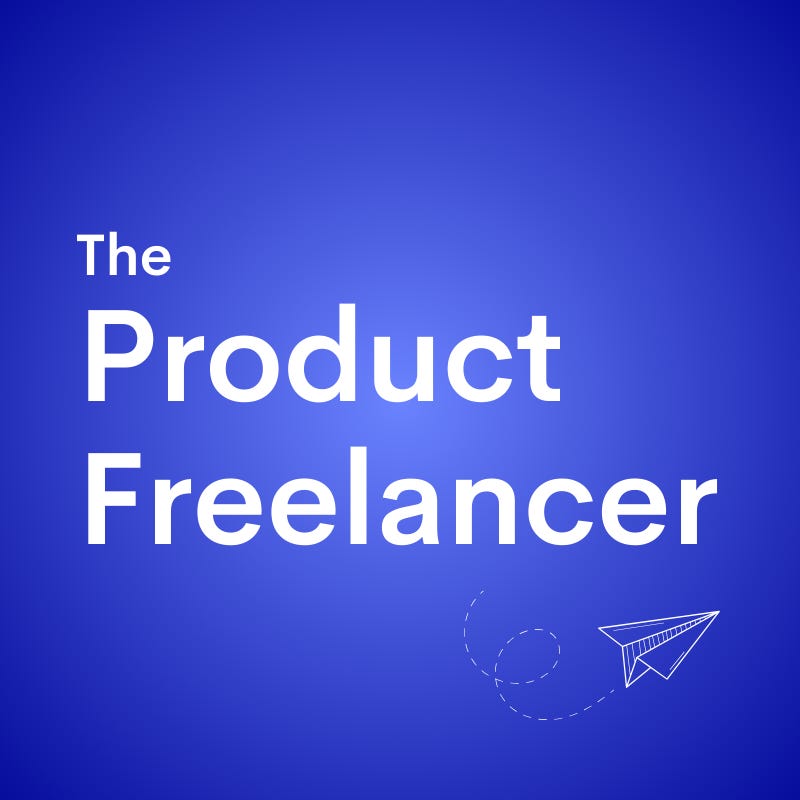4 AI use cases to save 15 hours/ week. ☀️
Missed our last articles? Here's your summer refresher.
Thank you for reading The Product Courier. We’re 1 402, which is 190 more than 30 days ago! 📈
If you’re new here welcome! We’re Lucas and Toni, both Product freelancers for early-stage start-ups. Lucas specialised in Product Marketing and Toni in Product Management.
In The Product Courier, we share actionable tips to help you deliver better work faster, and accelerate your career.
We also created a spin-off newsletter dedicated to freelancing, The Product Freelancer. Subscribe if you haven’t done it already!
In this #22 edition of The Product Courier, we talk about Founder mode, ChatGPT-Next and how you can easily save up to 15 hours/week with AI!
Brain food. 🧠
The “founder mode” by Paul Graham.
The conventional wisdom about how to run larger companies is mistaken. As Airbnb grew, well-meaning people advised him that he had to run the company in a certain way for it to scale: "hire good people and give them room to do their jobs." He followed this advice and the results were disastrous:
“The less hands-on I was, the more I got sucked into problems. And by the time I got sucked into a problem, it was like 10 times as much work”.
Paul Graham sharing bytes from a Brian Chesky talk.
Silicon Valley has been buzzing in recent days over one topic in particular: How founders should run their company when they scale? In his essay, Paul Graham opposes two different concepts:
Manager mode is a delegated, hierarchical approach where leaders treat departments as black boxes, minimizing direct involvement and relying on a chain of command for decision-making and operations.
Founder mode is a hands-on approach where the founder gets involved in specifics and details. This approach has reportedly been adopted by Jensen Huang from Nvidia with his 60 direct reports, and Elon Musk.
Although the founder mode approach is quite unconventional and can be compared to micro-management, it could lead to better outcomes for growing companies.
What are your thoughts on this? Would love to hear your opinion in the comment section.
The news of the week. 📰
“GPT Next” to be released soon?
Tadao Nagasaki, CEO of OpenAI Japan, announced that the upcoming GPT-Next model will be 100 times more powerful than GPT-4, thanks to improved architecture. He also mentioned that ChatGPT has surpassed 200 million active users, the fastest growth in software history.
I’m curious to test this new model. I don’t really expect OpenAI to release GPT-5 anytime soon, but the update from GPT-4 to GPT-4o was quite interesting for copywriting use cases for instance.
Community Polls. 📊
Your weekly tutorial: 4 AI use cases to save 15 hours/week.💡👩🏻💻
TL;DR ✨
✅ I've cut 15 hours from my work week using mostly a minimal AI stack: ChatGPT/Claude, Perplexity, and AI notetakers.
✅ These tools streamline four key areas: customer discovery, content creation, competitive intelligence, and meeting notes.
✅ By leveraging AI, I've not only saved time but also improved my work quality.
✅ The article provides practical tips and techniques for each area to help you achieve similar results.
Imagine slashing your workweek by 15 hours. Sounds too good to be true?
That's exactly what AI has done for me, and it can do the same for you.
Having witnessed numerous technological shifts in the product field, I can confidently say that none have been as transformative as the recent advancements in artificial intelligence.
During my time at Scaleway, integrating AI into my daily tasks helped me save up to 15 hours per week (roughly 30% – 40% of my working time).
Now, as a Product freelancer, I use AI every single day. For pretty much everything. From market research, to meeting preparation and data analysis.
Over the last few months, we've shared with Toni some techniques that we leverage on a daily basis – so you can save up to 15 hours too.
In this article, I'll recap 4 ways to use AI and automation in your daily job, using a minimal stack: ChatGPT/Claude, Perplexity, and AI notetakers.
Here's how you can leverage this stack:
Conduct customer discovery 10x more efficiently
Write better content, faster
Perform competitive intelligence effectively
Use an AI Notetaker to automate meeting notes
Conduct customer discovery 10x more efficiently.
Customer discovery is the cornerstone of product roles. Regularly talking to your customers isn't just important—it's mandatory. Period.
But let's face it – most of the time, PMs and PMMs struggle to find the time for it. This often results in products being designed based on gut feelings, which frequently leads to failure.
Customer discovery requires time and discipline. These are two challenges that AI and automation can help solve.
Using the right workflow, you can easily:
Do your prep work 90% faster
Automate the booking of customer interviews
Analyze large amounts of data in seconds
How?
We recently shared practical tips in the following articles:
These techniques not only save time but ensures you're consistently gathering valuable customer insights. It transforms customer discovery from a daunting task into a streamlined process, allowing you to make data-driven decisions with confidence.
⚠️ Remember, the goal isn’t to replace customer interview — it's to do it more frequently and effectively.
Write better. Write faster.
From emails and PRDs to blog posts, we spend countless hours writing each day.
This means that optimizing your writing process is one of the most effective ways to save time each week.
And guess what? That's where GenAI technologies truly shine nowadays.
This is especially valuable if, like me, English isn't your first language.
I regularly use AI to assist with copywriting. It helps me generate multiple versions of copy, craft compelling email subject lines, and refine my website taglines.
While AI-generated content always requires human refinement, it provides an excellent foundation to build upon. More importantly, it enables me to produce significantly more high-quality content in less time.
Here's a personal insight: I firmly believe that using AI is currently one of the most effective ways to learn and improve in a language. Its semantic precision far surpasses tools like Google Translate.
In essence, leveraging AI not only saves you valuable time but also enhances your copywriting skills.
I've compiled my go-to copywriting prompts in this article:
Perform competitive analysis efficiently.
To watch or not to watch your competitors closely?
This debate regularly heats up on LinkedIn, with strong opinions on both sides.
But as with any binary debate, we all know the only true answer is:
"Well, it depends."
I won't reignite that debate here – but I'm pretty sure that if you're working in product, you feel like you should be keeping a closer eye on your competitors.
Like customer discovery, following your competition requires time and discipline.
These are two things that are extremely challenging to maintain over time – other priorities always seem to get in the way.
Unless, of course, you automate the process.
Watching competitors effectively involves:
Collecting information from various data sources
Analyzing large volumes of data (usually text)
Communicating these results internally
In the following tutorials, we'll detail our personal workflows to help you save hours on steps 1 and 2.
Use an AI notetaker.
Did you know that executives spend an average of 23 hours a week in meetings? That's nearly a full day!
The real problem with meetings isn't the meetings themselves - it's how poorly they're often managed. No clear agenda, endless small talk, and... you guessed it, terrible note-taking.
Important points are raised, decisions are made, but people rely too heavily on their memory. The result? Wasted time, miscommunication, and frequently, revisiting topics we thought we'd already settled. 😭
This is where AI notetakers can be a game-changer. They can help you:
Stay more engaged and present during meetings
Rely on accurate, clear notes rather than fallible memory
Improve internal alignment and follow-through
AI notetakers act like tireless personal assistants, listening to your meetings and automatically generating comprehensive notes. Using advanced technologies like speech recognition and natural language processing, these tools capture key points, action items, and decisions made during your discussions.
By leveraging AI for note-taking, you're not just saving time - you're enhancing the quality of your meetings and improving team communication
Thank you for reading this edition of The Product Courier!
If you enjoy reading this article hit the ❤️. It helps us get better reach and encourages us to keep sharing great content from the community.
Wait! Before you leave:
We’ve recently shared our personal library of 30+ prompts for ChatGPT and Claude.
All our prompts are organised by use cases (market research, positioning, data analysis) and help you get great results from GenAI.
Using these prompt you’ll get incredible results from ChatGPT/Claude instantly.
As you’re a reader from The Product Courier, you can benefit from 30% off with the code "PRODUCTCOURIERCOMMUNITY30".
See you next Wednesday!













